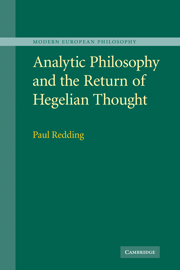Book contents
- Frontmatter
- Contents
- Acknowledgements
- Introduction: analytic philosophy and the fall and rise of the Kant–Hegel tradition
- 1 McDowell, Sellars and the myth of the perceptually given
- 2 Brandom, Sellars and the myth of the logical given
- 3 Individuation and determinate negation in Kant and Hegel
- 4 The Kantian route to Hegel's inferentialism
- 5 Aristotelian Phronesis and the perceptual discernment of value
- 6 Kant, Hegel and the dynamics of evaluative reason
- 7 Hegel and contradiction
- 8 Hegel, analytic philosophy and the question of metaphysics
- Bibliography
- Index
Introduction: analytic philosophy and the fall and rise of the Kant–Hegel tradition
Published online by Cambridge University Press: 22 September 2009
- Frontmatter
- Contents
- Acknowledgements
- Introduction: analytic philosophy and the fall and rise of the Kant–Hegel tradition
- 1 McDowell, Sellars and the myth of the perceptually given
- 2 Brandom, Sellars and the myth of the logical given
- 3 Individuation and determinate negation in Kant and Hegel
- 4 The Kantian route to Hegel's inferentialism
- 5 Aristotelian Phronesis and the perceptual discernment of value
- 6 Kant, Hegel and the dynamics of evaluative reason
- 7 Hegel and contradiction
- 8 Hegel, analytic philosophy and the question of metaphysics
- Bibliography
- Index
Summary
Should it come as a surprise when a technical work in the philosophy of language by a prominent analytic philosopher is described as ‘an attempt to usher analytic philosophy from its Kantian to its Hegelian stage’, as has Robert Brandom's Making It Explicit? It can if one has in mind a certain picture of the relation of analytic philosophy to ‘German idealism’. This particular picture has been called analytic philosophy's ‘creation myth’, and it was effectively established by Bertrand Russell in his various accounts of the birth of the ‘new philosophy’ around the turn of the twentieth century.
It was towards the end of 1898 that Moore and I rebelled against both Kant and Hegel. Moore led the way, but I followed closely in his footsteps. I think that the first published account of the new philosophy was Moore's article in Mind on ‘The Nature of Judgement’. Although neither he nor I would now adhere to all the doctrines in this article, I, and I think he, would still agree with its negative part – i.e. with the doctrine that fact is in general independent of experience.
Russell's accounts of his first eight years at Cambridge culminating in his rebellion against idealism convey a familiar picture of the precocious young man coming to find his distinctive voice.
- Type
- Chapter
- Information
- Publisher: Cambridge University PressPrint publication year: 2007



